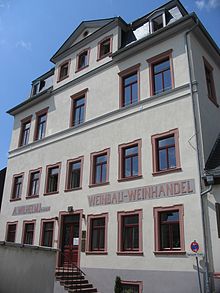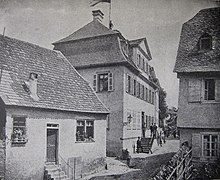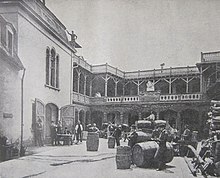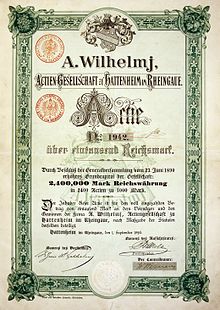Wilhelmj House
The Wilhelmj-Haus in Hattenheim in the Rheingau is the listed former residential and commercial building of the wine merchant August Wilhelmj and the Wilhelmj Weinhandels-Aktien-Gesellschaft .
description
The Wilhelmj House is a three-story, massive stone building from 1872, with the third floor coming from a later construction phase (around 1890). It is completed by a mansard roof with a mid-house . The windows are provided with sandstone embrasures. The front side facing the street bears the old lettering “A. Wilhelmj GMBH Viticulture - Wine Trade ”. The keystone above the arch of the gate entrance to the adjoining wine press hall shows the lettering “A. Wilhelmj ”as well as the Roman year 1872. Other farm buildings also date partly from the time it was built.
history
Company founder August Wilhelm Wilhelmj, born on June 19, 1813 in Langenschwalbach , studied law and political science at the University of Göttingen . From 1837 he worked as the court procurator of the ducal-Nassau court in Usingen , where he married Charlotte Petry, a well-known pianist, in 1843. Son Albert was born here in 1844 and son August, later celebrated as the “violinist” in 1845 . The relocation of the court and appeal court to Wiesbaden in 1849 made it necessary to move there.
Around this time Wilhelmj began to buy and collect top quality wines from the Rheingau , with which he was soon trading. Through the targeted purchase of the best vineyards in the years to come, his "Weinbureau", which was initially located at Adolfstrasse 7 in Wiesbaden, soon became known beyond the borders of the German Empire.
For the Frankfurt Fürstentag of 1863 he delivered wines from Rauenthal , which also impressed the King of the Netherlands so much that he bought a half piece (600 l) of them. At the World Exhibition in Paris in 1867 , Wilhelmj received the only gold medal for his wines , and his wines were drunk when the Suez Canal opened in 1869. Wilhelmj's many customers in the following years included the Russian Tsar Alexander II , Bismarck , and the German Kaiser . Wilhelmj was appointed purveyor to the court by him. Richard Wagner became a special friend of the house. At the world exhibition in Vienna in 1873 Wilhelmj was again able to celebrate great successes.
One of Wilhelmj's greatest achievements was to ensure that wines were finally named after their place of origin. Up until that time it was customary for wines to be named after the place to which they came closest in character, for example Marcobrunner , Johannisberger or Steinberger . These locations were predominantly owned by the aristocracy, small winemakers from places like Hattenheim, Hallgarten or Rauenthal had no way of selling their often excellent wines under their own place names, they only served the reputation of the large wineries. The designation of origin according to the place of origin is still valid today.
Son Albert, who had meanwhile become a lawyer, joined the company as a trading partner on July 1, 1872, in December his father resigned from civil service and devoted himself entirely to wine. In the same year Wilhelmj had acquired an estate in Hattenheim, on which he had today's manor house built according to plans by the building councilor Heinrich Velde and the architect Schaedel from Frankfurt. The work was carried out by the contractors Bott and Raschi from Eltville. The house with its extensive two- storey cellars had the most modern cellar technology with air ducts and ventilation shafts, with duct systems for water and sewage and, above all, pump systems with the help of which the wine could be pumped from cellar to cellar or to another floor and thus the hard and made dangerous grist of the wine barrels superfluous. The giant barrel from Hattenheim , which has not survived and which was made in the workshop of master cooper Ignatz Müller from Eltville in 1876 and which could hold 64,000 bottles , became legendary . In order to transport the barrel in one piece from Eltville to Hattenheim, both tracks of the Nassau Rheinbahn were required. It took three days to bring the barrel from the track to the adjacent construction site. The 6 m high dome was then built around the barrel. Wilhelmj moved the Wiesbaden office in 1885 from Adolfstraße to Wilhelmstraße 18, but apart from the office there was only a sample bottle warehouse there.
In 1888 the company was converted into a stock corporation . A year later Wilhelmj acquired the nearby Reichartshausen Castle and had this facility converted into a winery using the latest technical knowledge, including a water tower and a small power station. Electricity, water and telephone lines were laid underground to the headquarters in Hattenheim. From the middle of the 1890s, Wilhelmj then supplied the whole place with electricity.
At the turn of the century, the corporation was liquidated . One possible reason for the deterioration in the Wilhelmj's business situation could have been the incursion of phylloxera , which destroyed around three quarters of all vineyards in Europe by the beginning of the 20th century and became an existential threat to many winegrowers. His son Albert also died in 1905. Reichartshausen Palace had to be foreclosed in 1906.
Wilhelmj died on November 18, 1910 at the age of 97 in Hattenheim. He was buried in the Wiesbaden North Cemetery at the side of his wife, who died in 1903, and his two sons who had died before him. His estate was first transferred to the Prussian State Domain and was then acquired by the municipality of Hattenheim, which finally relocated the Georg Müller Foundation , which was donated to it in 1913, from today's Georg-Müller-Straße to the Wilhelmj-Haus. The winery, privatized in 2003, is still located in the Wilhelmj House today.
literature
- Ferdinand Ott: History of the House of A. Wilhelmj in Wiesbaden and Hattenheim , Verlag W. Zimmet, Wiesbaden 1887
- Karla Wiesinger: August Wilhelmj (1813-1910) A forgotten Rheingau wine pioneer in: Hedwig Witte: Famous Rheingau , Verlag Haag and Herchen, Frankfurt a. M. 1984, ISBN 3-88129-754-5
Individual evidence
- ↑ a b Vita August Wilhelm Wilhemj - Chronicle of Hattenheim ( Memento from February 16, 2015 in the Internet Archive )
- ^ Otto Renkhoff: Nassauische Biographie, self-published by the Historical Commission for Nassau, Wiesbaden 1985. ISBN 3-922244-68-8
- ↑ August Wilhelmy and the love wine chronicle of Hattenheim on Hattenheim.de
- ↑ The old procurator . In: Nassovia, magazine for Nassau history and local history, vol. 4, vol. 1903, p. 166
- ↑ 1889-1906: Reichartshausen becomes the seat of the "Wine King" August Wilhelmj Homepage European Business School ( Memento from October 2, 2013 in the Internet Archive )
Web links
Coordinates: 50 ° 0 '51.8 " N , 8 ° 3' 40.2" E





